Navigation
Aditi Mukherji, a senior social scientist based in International Water Management Institute (IWMI) Delhi office, has been announced as the first ever winner of the Norman Borlaug Award for Field Research and Application. The $10,000 award, endowed by the Rockefeller Foundation, will be presented on October 17, 2012, in Des Moines, Iowa, by the World Food Prize Foundation.
The winners were students Luigi Marshall Cham, Jun Yong Nicholas Lim and Tian Ting Carrie-Anne Ng from Singapore for their research on how clay can be used to remove and recover pollutants from wastewater. A Diploma of Excellence was given to Alonso Alvarez and Daniel Barrientos from Chile for their project which outlined how salmon waste from the fishing industry can be used for biofuel production.
Singapore Students Win
2012 Stockholm Junior Water Prize
PepsiCo received the Stockholm Industry Water Award at the 2012 World Water Week in Stockholm for its work to reduce water consumption in their operations and to help solve water challenges on a broad scale.
PepsiCo received the Stockholm Industry Water Award at the 2012 World Water Week in Stockholm for its work to reduce water consumption in their operations and to help solve water challenges on a broad scale.
The 2012 World Water Week (WWW) in Stockholm, Sweden, organized by the Stockholm International Water Institute Stockholm (SIWI), undertook the task of addressing crucial concerns focusing on "Water and Food Security," with publications and videos prepared in advance to provide background and to stimulate conversations among the 2,500 WWW participants in order to build on knowledge what is successfully working and to advance positive action.
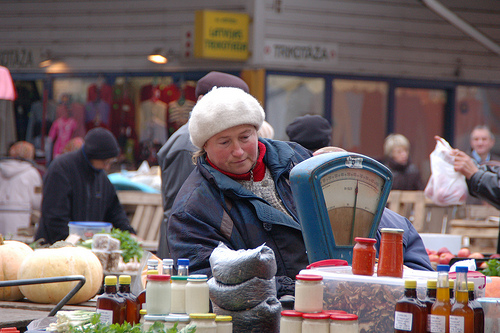 Woman at food market in Riga, Latvia.: Photo credits: Jakob Granit, SIWI.
Woman at food market in Riga, Latvia.: Photo credits: Jakob Granit, SIWI.
“…once we can secure access to clean water and to adequate sanitation facilities for all people, irrespective of the difference in their living conditions, a huge battle against all kinds of diseases will be won," said the late Dr. Lee Jong-wook, when Director-General of WHO.
The six winners of the WASH Media Award for excellence in reporting on Water, Sanitation and Hygiene-related (WASH) Issues received their awards during a ceremony on 31 August 2012 at the World Water Week (WWW) in Stockholm, Sweden. During the week, the journalists shared their experiences on reporting WASH issues with leading water, sanitation, environment and development experts.
The six winners of the WASH Media Award for excellence in reporting on Water, Sanitation and Hygiene-related (WASH) Issues received their awards during a ceremony on 31 August 2012 at the World Water Week (WWW) in Stockholm, Sweden. During the week, the journalists shared their experiences on reporting WASH issues with leading water, sanitation, environment and development experts.
Over 2500 politicians, business leaders, and representatives of 200 international organizations are meeting at the World Water Week in Stockholm, August 26-31 2012, where they are working to share knowledge of solutions and to forge new solutions to meet rapidly escalating demands for limited water and land from all sectors of the economy.
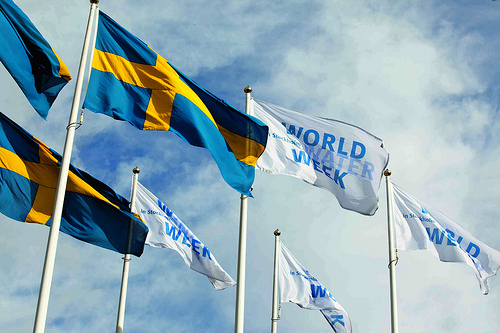 The World Water Week in Stockholm is the annual meeting place for the planet’s most urgent water-related issues.: Organized by the Stockholm International Water Institute (SIWI), it brings together thousands of experts, practitioners, decision makers and business innovators from around the globe to exchange ideas, foster new thinking and develop solutions www.worldwaterweek.org. Photograph courtesy of SIWI,
The World Water Week in Stockholm is the annual meeting place for the planet’s most urgent water-related issues.: Organized by the Stockholm International Water Institute (SIWI), it brings together thousands of experts, practitioners, decision makers and business innovators from around the globe to exchange ideas, foster new thinking and develop solutions www.worldwaterweek.org. Photograph courtesy of SIWI,
Sainsbury's has installed 69,500 new photovoltaic solar panels, or 16 MW of power, across 169 stores in the UK. The significant investment means collectively Sainsbury's supermarkets currently host the largest solar array in the UK and Europe. The solar power will reduce Sainsbury's total CO2 emissions by an estimated 6,800 tonnes per year, and each store's energy consumption as well as delivering energy cost savings.
 One of 69,500 photovoltaic solar panels that have been installed on the roof of Sainsbury’s supermarkets:: generating enough power for 4,100 homes. Sainsbury’s is now the largest multiroof solar panel operator in the UK and Europe.
One of 69,500 photovoltaic solar panels that have been installed on the roof of Sainsbury’s supermarkets:: generating enough power for 4,100 homes. Sainsbury’s is now the largest multiroof solar panel operator in the UK and Europe.
The newly discovered mechanism triggering the blooming of countless microscopic plant plankton, or phytoplankton, in the North Atlantic helps explain the timing of the spring and summer bloom, known to mariners and fishers for centuries and clearly visible in satellite images.
Phenomenon of spring and summer is jump-started by swirling currents of seawater
 The North Atlantic Bloom: swirling artwork in the sea, plankton bloom in spring, summer.: Photograph courtesy of NASA Earth Observatory View a photo gallery showing the North Atlantic Bloom.
The North Atlantic Bloom: swirling artwork in the sea, plankton bloom in spring, summer.: Photograph courtesy of NASA Earth Observatory View a photo gallery showing the North Atlantic Bloom.
On this July 4th week, U.S. beachgoers are thronging their way to seaside resorts and parks to celebrate with holiday fireworks.
Study Reveals the Potentially Large Influences of Fungi, One of the Most Biologically Diverse Classes of Organisms, On Our Energy Supplies
A new study which includes the first large-scale comparison of fungi that cause rot decay suggests that the evolution of a type of fungi known as white rot may have brought an end to a 60-million-year-long period of coal deposition known as the Carboniferous period. Coal deposits that accumulated during the Carboniferous, which ended about 300 million years ago, have historically fueled about 50 percent of U.S. electric power generation.
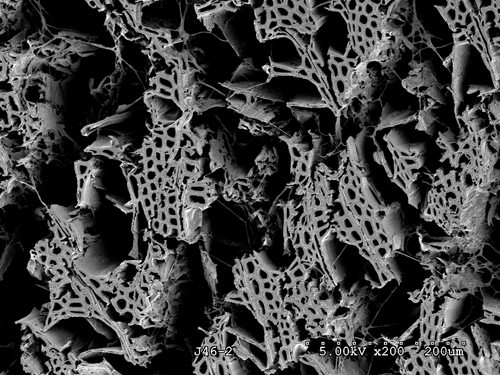 A scanning electron micrograph of wood that has been decayed by white rot.: The white filaments of the fungi can be seen among the degraded wood cells. They produce a diverse array of enzymes that degrade the wood. The wood structure, including lignin and cellulose, has been largely destroyed by the fungus. Photograph courtesy of Robert A. Blanchette / Joel . Jurgens, University of Minnesota
A scanning electron micrograph of wood that has been decayed by white rot.: The white filaments of the fungi can be seen among the degraded wood cells. They produce a diverse array of enzymes that degrade the wood. The wood structure, including lignin and cellulose, has been largely destroyed by the fungus. Photograph courtesy of Robert A. Blanchette / Joel . Jurgens, University of Minnesota
In the midst of a South Bronx, New York City neighborhood known for blight, poverty, pollution and crime, families are now moving into a very special residential complex named Via Verde, The Green Way, that was designed for healthy living.
 East facing façade on Brook Avenue, South Bronx.: Photograph © David Sundberg/ESTO
East facing façade on Brook Avenue, South Bronx.: Photograph © David Sundberg/ESTO
In the midst of a South Bronx, New York City neighborhood known for blight, poverty, pollution and crime, families are now moving into a very special residential complex named Via Verde, The Green Way, that was designed for healthy living.
- Climate change
- CO2
- compact fluorescent
- consumption
- developing
- efficient lighting
- electricity
- en.lighten
- energy
- energy efficient
- GEF
- global carbon emissions
- Global climate change
- Global Environment Facility
- global lights
- greenhouse gas
- incandescent
- inefficient
- LED
- light bulb
- lighting
- Osram
- Philips
- transformation
- UNEP enlighten
- United Nations
- Energy
- Global Climate Change
- Industry
A total of five percent of global electricity consumption could be saved every year through a transition to efficient lighting, resulting in annual worldwide savings of over US$ 110 billion. These are among the main findings of 150 country lighting assessments and a new global policy map on efficient lighting. An en.lighten press conference at Rio +20 highlighted the planned phase-out of inefficient lighting which is designed to deliver major economic and climate benefits by 2016.
Lighting is responsible for nearly 20% of the world's total electricity consumption and almost 6% of worldwide CO2 emissions. Simply shifting to efficient lighting would cut the electricity used for lighting globally by half.
Venezuela set forth a series of measures this week to protect sharks within its waters. Most significantly, commercial shark fishing is now prohibited throughout the 3,730 square kilometers (1,440 square miles) of the Caribbean Sea that make up the popular Los Roques and Las Aves archipelagos, whose pristine beaches and coral reefs make it a diving and fishing attraction.
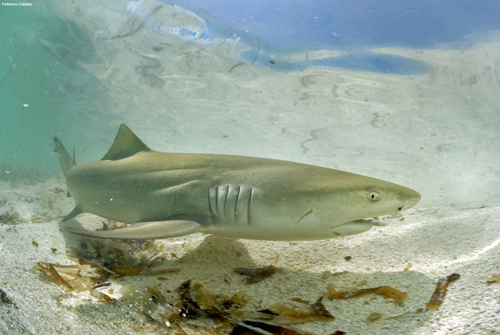 Lemon sharks are now protected by the shark fishing ban implemented in the Los Roques Archipelago off of Venezuela.: Photograph by Federico Cabello
Lemon sharks are now protected by the shark fishing ban implemented in the Los Roques Archipelago off of Venezuela.: Photograph by Federico Cabello
A new initiative aims to build a comprehensive tree of life that brings together everything scientists know about how all species are related, from the tiniest bacteria to the tallest tree. Information about evolutionary relationships is fundamental to comparative biology research. It helps scientists identify promising new medicines; develop hardier, higher-yielding crops; and fight infectious diseases such as HIV, anthrax and influenza.
 The "Open Tree of Life" is one of three major new scientific projects funded by the NSF.: This initial tree of life, called the Open Tree of Life, will not be static. Scientists will develop tools for researchers to update and revise the tree as new data come in. Photograph courtesy of NSF National Evolutionary Synthesis Center
The "Open Tree of Life" is one of three major new scientific projects funded by the NSF.: This initial tree of life, called the Open Tree of Life, will not be static. Scientists will develop tools for researchers to update and revise the tree as new data come in. Photograph courtesy of NSF National Evolutionary Synthesis Center
The U.S. Environmental Protection Agency (EPA) and the U.S. Department of Veterans Affairs (VA) Vocational Rehabilitation and Employment Program agreement announced today allows EPA and VA to connect qualified veteran employees with staffing needs at water and wastewater utilities. EPA and the VA will work with water utilities, states and local VA counselors to promote water sector careers and resources for finding water jobs for veterans as well as educational programs to help veterans' transition into careers in water industries.
[img_assist|nid=743|title=Worker at Water Plant|desc=Water sector professionals are vital to protecting public health through the operation and maintenance of water and wastewater treatment plants. They ensure that clean and safe water is consistently provided to the public. For this reason, EPA is concerned about predicted workforce losses to the industry through retirements.
SHOAL, the pan-European ICT project, part funded by the EU, has successfully developed and delivered intelligent robotic fish capable of working together to detect and identify pollution in ports and other aquatic areas.
 If the robotic fish try to find the source of the pollution they find: If the robotic fish try to find the source of the pollution they find, as soon as they have determined the source they will immediately contact the port via the ultrasonic communications so that the port can take any appropriate measures to deal with stopping the source of the pollution. Photograph courtesy of SHOAL.
If the robotic fish try to find the source of the pollution they find: If the robotic fish try to find the source of the pollution they find, as soon as they have determined the source they will immediately contact the port via the ultrasonic communications so that the port can take any appropriate measures to deal with stopping the source of the pollution. Photograph courtesy of SHOAL.
A record six fish populations were declared rebuilt to healthy levels in 2011, bringing the number of rebuilt U.S. marine fish populations in the last 11 years to 27, according to a report to Congress out today from NOAA’s Fisheries Service. This report documents historic progress toward ending overfishing and rebuilding our nation’s fisheries, due to the commitment of fishermen, fishing communities, non-governmental organizations, scientists, and managers.
[img_assist|nid=732|title=Chinook salmon, Oncorhynchus tshawytscha|desc=The scientific name for Chinook salmon, Oncorhynchus tshawytscha, is derived from the Greek words “onkos” (hook), “rynchos” (nose), and “tshawytscha” (the common name for the species in Siberia and Alaska). New scientific information and analyses about the Southern Resident population of killer whales and the extent of their reliance on salmon – particularly large chinook salmon – strongly suggest that chinook abundance is very important to survival and recovery of these whales.
Ten Thousand Villages creates opportunities for artisans in developing countries who would otherwise be unemployed or underemployed to earn income by bringing their products and stories to our markets through long-term, fair trading relationships. The income artisans earn helps pay for food, education, health care, and housing.
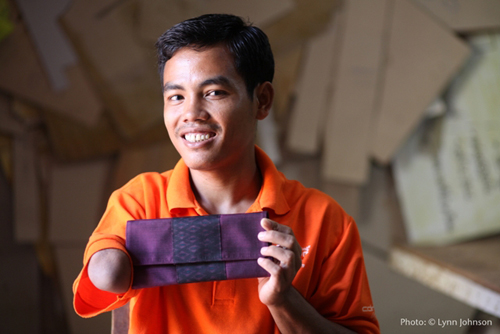
Ten Thousand Villages creates opportunities for artisans in developing countries who would otherwise be unemployed or underemployed to earn income by bringing their products and stories to our markets through long-term, fair trading relationships. The income artisans earn helps pay for food, education, health care, and housing.
Cook+Fox Architects are finding ways to achieve their vision of integrated, environmentally responsive design inspired by concepts such as Biophilia. They not only incorporate Leadership in Energy and Environmental Design (LEED) criteria, but seek to go beyond those standards as they design to restore, regenerate, and contribute to the urban environment.
Cook+Fox Architects - OBP_500 1_edited-1.jpg) The Bank of America Tower at One Bryant Park, New York, NY: Photograph ©Cook+Fox Architects
The Bank of America Tower at One Bryant Park, New York, NY: Photograph ©Cook+Fox Architects
An innovative tool for teaching the fundamentals of epidemiology, the science of how infectious diseases move through a population, has been developed by an international team of scientists. The tool is helping epidemiologists improve the mathematical models they use to study outbreaks of diseases like cholera, AIDS and malaria.
 Researchers Use Game to Change How Scientists Study Disease Outbreaks: Epidemiologists are improving mathematical models used to study disease outbreaks. Photograph courtesy of NIHIt may seem like a game of tag, but it's an innovative tool for teaching the fundamentals of epidemiology, the science of how infectious diseases move through a population.
Researchers Use Game to Change How Scientists Study Disease Outbreaks: Epidemiologists are improving mathematical models used to study disease outbreaks. Photograph courtesy of NIHIt may seem like a game of tag, but it's an innovative tool for teaching the fundamentals of epidemiology, the science of how infectious diseases move through a population.
- Africa
- Agriculture
- agriculture
- ecosystem services
- environment
- farmers
- food
- Ghana
- hygiene
- International Water Management Institute
- IWMI
- life-support systems
- safety
- SIWI
- Stockholm Water Prize
- wastewater
- water management
- youth
- News and Special Reports
- Public Health
- Waste Management
- Water
- Water and Sanitation
The International Water Management Institute (IWMI), with headquarters in Colombo, Sri Lanka, has been named the 2012 Stockholm Water Prize Laureate for their pioneering research that has served to improve agriculture water management, enhance food security, protect environmental health and alleviate poverty in developing countries.
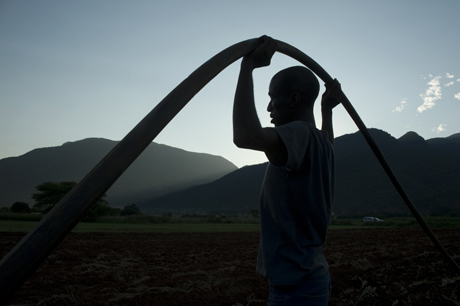 The groundwater boom in Asia has increased the productivity of many farmers: but careful analysis is now needed to manage this sustainably. The groundwater potential for African farmers is huge and new research is seeking to identify the most cost effective opportunities. Photo: Graeme Williams/IWMI
The groundwater boom in Asia has increased the productivity of many farmers: but careful analysis is now needed to manage this sustainably. The groundwater potential for African farmers is huge and new research is seeking to identify the most cost effective opportunities. Photo: Graeme Williams/IWMI
Search
Latest articles
Agriculture
- World Water Week: Healthy ecosystems essential to human health: from coronavirus to malnutrition Online session Wednesday 24 August 17:00-18:20
- World Water Week: Healthy ecosystems essential to human health: from coronavirus to malnutrition Online session Wednesday 24 August 17:00-18:20
Air Pollution
- "Water and Sanitation-Related Diseases and the Changing Environment: Challenges, Interventions, and Preventive Measures" Volume 2 Is Now Available
- Global Innovation Exchange Co-Created by Horizon International, USAID, Bill and Melinda Gates Foundation and Others
Biodiversity
- World Water Week: Healthy ecosystems essential to human health: from coronavirus to malnutrition Online session Wednesday 24 August 17:00-18:20
- Mangrove Action Project Collaborates to Restore and Preserve Mangrove Ecosystems
Desertification
- World Water Week: Healthy ecosystems essential to human health: from coronavirus to malnutrition Online session Wednesday 24 August 17:00-18:20
- UN Food Systems Summit Receives Over 1,200 Ideas to Help Meet Sustainable Development Goals
Endangered Species
- Mangrove Action Project Collaborates to Restore and Preserve Mangrove Ecosystems
- Coral Research in Palau offers a “Glimmer of Hope”
Energy
- Global Innovation Exchange Co-Created by Horizon International, USAID, Bill and Melinda Gates Foundation and Others
- Wildlife Preservation in Southeast Nova Scotia
Exhibits
- Global Innovation Exchange Co-Created by Horizon International, USAID, Bill and Melinda Gates Foundation and Others
- Coral Reefs
Forests
- NASA Satellites Reveal Major Shifts in Global Freshwater Updated June 2020
- Global Innovation Exchange Co-Created by Horizon International, USAID, Bill and Melinda Gates Foundation and Others
Global Climate Change
- World Water Week: Healthy ecosystems essential to human health: from coronavirus to malnutrition Online session Wednesday 24 August 17:00-18:20
- Mangrove Action Project Collaborates to Restore and Preserve Mangrove Ecosystems
Global Health
- World Water Week: Healthy ecosystems essential to human health: from coronavirus to malnutrition Online session Wednesday 24 August 17:00-18:20
- More than 400 schoolgirls, family and teachers rescued from Afghanistan by small coalition
Industry
- "Water and Sanitation-Related Diseases and the Changing Environment: Challenges, Interventions, and Preventive Measures" Volume 2 Is Now Available
- Global Innovation Exchange Co-Created by Horizon International, USAID, Bill and Melinda Gates Foundation and Others
Natural Disaster Relief
- STOP ATTACKS ON HEALTH CARE IN UKRAINE
- Global Innovation Exchange Co-Created by Horizon International, USAID, Bill and Melinda Gates Foundation and Others
News and Special Reports
- World Water Week: Healthy ecosystems essential to human health: from coronavirus to malnutrition Online session Wednesday 24 August 17:00-18:20
- STOP ATTACKS ON HEALTH CARE IN UKRAINE
Oceans, Coral Reefs
- World Water Week: Healthy ecosystems essential to human health: from coronavirus to malnutrition Online session Wednesday 24 August 17:00-18:20
- Mangrove Action Project Collaborates to Restore and Preserve Mangrove Ecosystems
Pollution
- Zakaria Ouedraogo of Burkina Faso Produces Film “Nzoue Fiyen: Water Not Drinkable”
- "Water and Sanitation-Related Diseases and the Changing Environment: Challenges, Interventions, and Preventive Measures" Volume 2 Is Now Available
Population
- "Water and Sanitation-Related Diseases and the Changing Environment: Challenges, Interventions, and Preventive Measures" Volume 2 Is Now Available
- "Water and Sanitation-Related Diseases and the Changing Environment: Challenges, Interventions, and Preventive Measures" Volume 2 Is Now Available
Public Health
- Honouring the visionary behind India’s sanitation revolution
- Honouring the visionary behind India’s sanitation revolution
Rivers
- World Water Week: Healthy ecosystems essential to human health: from coronavirus to malnutrition Online session Wednesday 24 August 17:00-18:20
- Mangrove Action Project Collaborates to Restore and Preserve Mangrove Ecosystems
Sanitation
- Honouring the visionary behind India’s sanitation revolution
- Honouring the visionary behind India’s sanitation revolution
Toxic Chemicals
- "Water and Sanitation-Related Diseases and the Changing Environment: Challenges, Interventions, and Preventive Measures" Volume 2 Is Now Available
- Actions to Prevent Polluted Drinking Water in the United States
Transportation
- "Water and Sanitation-Related Diseases and the Changing Environment: Challenges, Interventions, and Preventive Measures" Volume 2 Is Now Available
- Urbanization Provides Opportunities for Transition to a Green Economy, Says New Report
Waste Management
- Honouring the visionary behind India’s sanitation revolution
- Honouring the visionary behind India’s sanitation revolution
Water
- Honouring the visionary behind India’s sanitation revolution
- Honouring the visionary behind India’s sanitation revolution
Water and Sanitation
- Honouring the visionary behind India’s sanitation revolution
- Honouring the visionary behind India’s sanitation revolution

